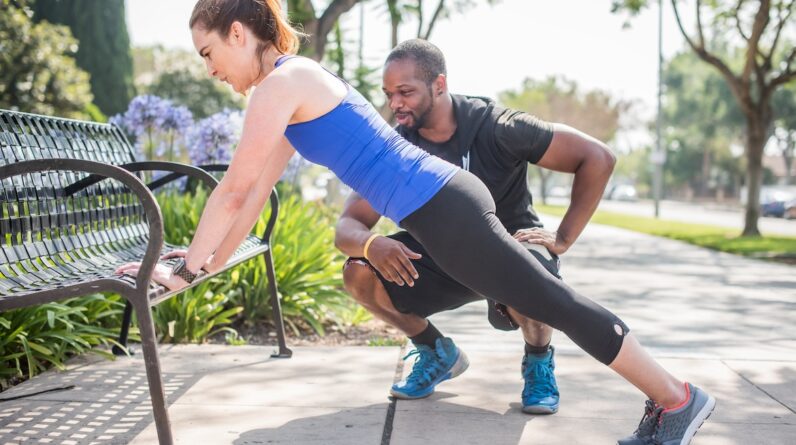
Sarah Cottrell’s relationship with movement—and her body—has long been complicated. In high school, she battled an undiagnosed eating disorder that stirred up toxic exercise practices. She recalls feeling like she was “bad” if she didn’t work out a certain way, and she engaged in cyclic dieting in an attempt to fit the societal idea of an “acceptable” body.
At age 30, therapy helped her understand the gravity of her situation when she was a teen; her provider said her experience would meet the clinical definition for an anorexia diagnosis, Cottrell says.
Experts In This Article
- Andrea Sutton, DPT, CPt, a certified personal trainer and strength coach in Raleigh, North Carolina, who emphasizes body liberation
- Barb Puzanovova, CPT, a certified personal trainer in Nashville who emphasizes a non-diet, health-at-any-size approach
- Jenna DiLossi, PsyD, a licensed clinical psychologist who specializes in cognitive-behavioral treatments for eating disorders and body image concerns
- Leslie Jordan Garcia, CPT, a certified personal trainer and group fitness instructor in Austin
After a few years of sessions, the lawyer-turned-career-coach began to explore the idea of easing back into healthy movement—no easy task, she says, considering her self-described perfection-seeking personality and the “very complicated experience” of now living in a larger body in a society where diet culture persists.
“Especially because I was getting older, I wanted to be doing more formal lifting of weights for all the reasons that one is supposed to do those things,” Cottrell says. “I wanted to be able to do it in a way that had some structure around it but also wasn’t with [a trainer] who was like, ‘Oh, you have a body of a certain type. It needs to be different.’ Especially because of my eating disorder history, that feels incredibly unsafe.”
That’s when she found Barb Puzanovova, CPT, a certified personal trainer in Nashville who emphasizes a non-diet, health-at-any-size approach. The duo started training together virtually once a week, then bumped up to twice-weekly sessions.
Puzanovova programs their strength-training sessions, corrects form, and offers modifications when needed. Over the last year and a half, they’ve tracked Cottrell’s progress: the amount of weight she can lift, the number of reps she can power through, her stamina as she tackles everyday activities, how she feels in her body.
Weight loss—often a data point used by trainers to gauge health improvement—has never been referenced.
Puzanovova is one of a growing number of personal trainers coaching their clients through a weight-neutral lens, an antidote to the harmful effects of diet culture1 and the pervasiveness of weight bias among exercise professionals. It’s an approach that prioritizes holistic well-being while shunning the scale, helping to promote a sustainable relationship with exercise—a reward Cottrell has experienced herself.
“I feel like I’m able to focus on the things that, to me, actually matter,” she says. “I think that for so many of us—and this was certainly true for me, especially pre-therapy—the way we get ourselves to move our bodies in workout-y ways is by shaming ourselves…[Exercise] was a thing that I needed so that I could sort of survive the shame. And now, it’s just like, ‘Hey, this is something I’m doing.’ That’s part of why I’m still working with [Barb] almost two years later.”
“You are who you are, so whether you’re in a [bigger] body or smaller body, I am not trying to change who you are. I’m here to affirm that…Weight loss may happen—because when you move your body, your body can change—but that’s not who the whole person is.” —Andrea Sutton, DPT, CPT
Taking a weight-neutral approach to personal training
The standard approach to fitness coaching is generally founded on the goals of building strength or muscle, improving sports performance, or, in many cases, weight loss, Puzanovova says.
Healthcare providers as a whole have “increasingly [felt] a responsibility to address the obesity epidemic” and help patients “achieve a healthy weight,” according to a 2017 essay published in Preventing Chronic Disease2.
But in American adults who have overweight and obesity, the annual probability of attaining weight loss of 5 percent or more (known as “clinically meaningful weight loss”) is just one in 10, according to a sweeping 2023 analysis in JAMA Network Open. Meanwhile, the occurrence of weight stigma—linked1 with chronic inflammation and increased rates of anxiety, depression, and disordered eating—has risen by 66 percent, coinciding with public health campaigns to stop the “obesity epidemic.”
Enter: a weight-neutral, non-diet approach to fitness coaching. The exact details vary from trainer to trainer, but the method is always rooted in the same idea: Weight is not the only indicator of health, nor a useful one at that.
“I like to describe weight as something that we can keep an eye on,” Puzanovova says. “If we gain a lot of weight or lose a lot of weight…we might treat that as maybe something to look into and maybe ask more questions—[but] that’s out of my scope of practice. So for me, I feel like weight is irrelevant in our training.”
Clients won’t be asked to step on the scale or have their bodily measurements taken at any point in their training. Caloric burn isn’t referenced. Intentional weight loss is never the goal—though there is an upfront acknowledgment that clients might gain, lose, or maintain weight for many reasons, inside the gym and out.
“When we take the intentional weight loss, fat loss, or aesthetic goal off the table, what else is left? What do you actually care about? What’s important for you to enhance the quality of your life?” Puzanovova says. “I think that’s really what people are looking for when they’re making a weight-loss goal. They’re maybe wanting more energy or better sleep or more mobility, and I always like to remind [people] we can achieve those things without focusing on weight loss.”
That means training programs are centered around boosting clients’ quality of life—to be able to finish a 5K, keep up with their kids as they grow, or garden without feeling achy—or improving other reliable health metrics, such as blood pressure, resting heart rate, and bone density.
Weight is not the only indicator of health, nor a useful one at that.
To measure progress, trainers might reference a client’s rate of perceived exertion, range of motion, reps and sets completed, and recovery time needed between, Puzanovova says. There’s also qualitative data, like how challenging it is to pick a box of kitty litter off the floor or carry groceries up three flights of steps. “And that the whole time, they did not have to weigh themselves to determine if [their training] is ‘working,’” she adds.
For the record, a weight-neutral approach is not “glorifying ‘obesity,’” says Andrea Sutton, DPT, CPT, a certified personal trainer and strength coach in Raleigh, North Carolina, who emphasizes body liberation.
“The only thing that I want to glorify is the person who is taking the time to move so they can feel better in their body,” she says. “The research says that there are more people who are plus-size or fat than there are in a smaller body, so it’s like we’re actually just trying to give voice to people who haven’t been heard or even seen in decades.” (Not to mention, the concept of body mass index5 was created by folks who were not medical professionals, and its standards are largely based on Caucasian men of European descent.)
Instead, it emphasizes that all bodies can and should be in motion—and that there isn’t one “right” way to move, says Leslie Jordan Garcia, CPT, a certified personal trainer and group fitness instructor in Austin. Any modality—dance, Tabata, HIIT, strength training, or yoga—is welcome so long as it’s enjoyable and sustainable.
“It shouldn’t be such an adversarial or punitive relationship with movement,” she says. “I think to get more people to move, we need to shift as an industry [away] from that frame of, ‘No pain, no gain. You need to have these 1,000 calories burned in a workout.’ As a trainer, I just meet people where they are.” In practice, Jordan Garcia encourages her clients and class participants to measure how many minutes of joy they experienced throughout their workout.
The bottom line: Outward appearance isn’t a reflection of health; aesthetic alone doesn’t indicate mental, emotional, social, or physical well-being, Jordan Garcia says. A weight-neutral coach takes all of those dimensions into consideration.
“You are who you are, so whether you’re in a [bigger] body or smaller body, I am not trying to change who you are. I’m here to affirm that,” Sutton adds. “…Weight loss may happen—because when you move your body, your body can change—but that’s not who the whole person is.”
“When I talk about movement, I always say it’s not about making your body smaller; it’s about making your life bigger and expanding your capacity to engage in life’s big and little adventures…It’s a way to care for ourselves in the here and now and in the future.” —Barb Puzanovova, CPT
The impact of weight-neutral training
For some people, particularly those with healthy bodily relationships, striving toward a weight-loss goal isn’t inherently going to be harmful, says Jenna DiLossi, PsyD, a licensed clinical psychologist who specializes in cognitive-behavioral treatments for eating disorders and body image concerns, among other issues. That said, there is benefit to recentering movement routines around enhancing daily function and other health metrics even if weight isn’t a sensitive subject, she notes.
The way we talk about movement—and bodies—does matter. Consider research published in the Journal of Clinical Sport Psychology. In a 2018 study, more than 200 women who participated in a short group fitness class were motivated with either “appearance-focused” comments (think: “Blast that cellulite!) or “function-focused” comments (e.g., “Think of how strong you’re getting!”). After class, the participants who received the function-focused comments felt significantly better about their bodies and had a better mood than those who were motivated with appearance-related remarks.
“If we could go back in time and just erase messaging around weight in either direction and do a whole societal lobotomy—make it like we’ve only ever really cared about health, sustaining your life as long as possible, and living the life you want to live—I think we’d have a lot more active people and people who are active in a way that is joyful for them,” DiLossi says. “I think we’d have a lot less people who use exercise as a punishment.”
To Puzanovova, a weight-neutral approach is also an evidence-based one. Grip strength, for instance, is correlated with a risk of premature and all-cause mortality, according to research in Frontiers in Public Health and Age and Ageing. Higher levels of upper- and lower-body strength are also linked9 with a lower risk of mortality in adults, regardless of age. And balance disorder (which may, in part, be attributed to proprioception and musculoskeletal function) is associated10 with an increased risk of all-cause, cardiovascular disease, and cancer mortality.
Each of these health metrics can be assessed, trained, and improved upon in a weight-neutral fitness setting. “There are so many things that we can measure now that can tell us something about long-term health and [are] actually a lot more correlated than weight,” Puzanovova says.
It pays off in the long run, too. Sutton has seen clients and class members with larger bodies quickly gain confidence in weight-neutral fitness settings; they slowly shed the society-instilled notions that they’re “weak” or “lazy” and begin to feel more open and excited to explore new movement methods, she says. While the number on the scale may take a couple weeks or months to reflect their new routine, a potentially disheartening situation in a weight-focused program, their performance in the gym and in everyday life can start to shift after just a few sessions, Puzanovova adds.
This new mindset often translates into a sustainable exercise practice. “Weight is such an emotionally charged topic in our society,” DiLossi says. “As soon as we attach weight loss and changing the body to [movement], I think it creates a bit of a different pressure. I think humans are just much [more] likely to fall off of it and not keep consistent, and it makes us more vulnerable to that all-or-nothing thinking.”
But when the “why” behind exercise is centered on enhancing and maintaining overall well-being, folks are more likely to stick with it; there’s no arbitrary number on the scale to achieve, so movement remains a key pillar of one’s lifestyle over time, DiLossi explains.
Research backs up this idea: In a 2016 study in Appetite, 80 women with “high body mass index” participated in a health promotion program that was either weight-neutral or weight loss-focused. After six months, the women in the weight-neutral program had experienced greater reductions in LDL (aka “bad”) cholesterol than the weight-loss group. While the latter group showed larger reductions in weight and BMI, the former demonstrated similar improvements in physical activity levels, fruit and vegetable intake, self-esteem, and quality of life two years later, according to the authors.
Essentially, “being able to take weight off of our main priority really allows us to both tend to our health now and then also tend to our health 10 to 20 years in the future,” Puzanovova says. “You can do both at the same time.”
An approach for anybody and any body
Thanks to the emphasis on joyful movement in any shape or form, a weight-neutral, body-liberating lens can be accessible and approachable to individuals of all body sizes and abilities. “Anybody with a body, this approach is for you,” Sutton says.
That said, working with a weight-neutral coach may be particularly valuable for individuals who have been left out of traditional movement spaces, had poor experiences with fitness in the past, or experienced trauma, Sutton says. The same goes for individuals who tend to view working out as a punishment or a chore, feel negatively affected by toxic wellness culture, or are brand-new to movement in general, according to the trainers. Even former athletes who may struggle to shift away from the intense training of their sports days can benefit, Puzanovova says.
In approaching fitness with this lens, clients build a foundation of fitness that empowers them to achieve real-life goals— whether it be hiking a cross-country trail, playing on a rec soccer league, or simply walking the dog without feeling winded—not a baseless number on the scale.
“When I talk about movement, I always say it’s not about making your body smaller; it’s about making your life bigger and expanding your capacity to engage in life’s big and little adventures,” Puzanovova says. “…It’s a way to care for ourselves in the here and now and in the future.”
Well+Good articles reference scientific, reliable, recent, robust studies to back up the information we share. You can trust us along your wellness journey.
- Fitterman-Harris HF, Davis GG, Bedard SP, Cusack CE, Levinson CA. Digital Mental Health Interventions: Differences in Diet Culture Intervention Framing. Int J Environ Res Public Health. 2023 Dec 23;21(1):24. doi: 10.3390/ijerph21010024. PMID: 38248489; PMCID: PMC10815398.
- Dollar E, Berman M, Adachi-Mejia AM. Do No Harm: Moving Beyond Weight Loss to Emphasize Physical Activity at Every Size. Prev Chronic Dis. 2017 Apr 20;14:E34. doi: 10.5888/pcd14.170006. PMID: 28427483; PMCID: PMC5420445.
- Kompaniyets L, Freedman DS, Belay B, Pierce SL, Kraus EM, Blanck HM, Goodman AB. Probability of 5% or Greater Weight Loss or BMI Reduction to Healthy Weight Among Adults With Overweight or Obesity. JAMA Netw Open. 2023 Aug 1;6(8):e2327358. doi: 10.1001/jamanetworkopen.2023.27358. Erratum in: JAMA Netw Open. 2023 Aug 1;6(8):e2332740. PMID: 37548978; PMCID: PMC10407685.
- Fitterman-Harris HF, Davis GG, Bedard SP, Cusack CE, Levinson CA. Digital Mental Health Interventions: Differences in Diet Culture Intervention Framing. Int J Environ Res Public Health. 2023 Dec 23;21(1):24. doi: 10.3390/ijerph21010024. PMID: 38248489; PMCID: PMC10815398.
- Pray R, Riskin S. The History and Faults of the Body Mass Index and Where to Look Next: A Literature Review. Cureus. 2023 Nov 3;15(11):e48230. doi: 10.7759/cureus.48230. PMID: 38050494; PMCID: PMC10693914.
- Engeln R, Shavlik M, Daly C. Tone it Down: How Fitness Instructors’ Motivational Comments Shape Women’s Body Satisfaction. Journal of Clinical Sport Psychology. 2018;12(4):508-524. doi:10.1123/jcsp.2017-0047
- Wang Y, Meng T, Yang W, Yan M, Su X, Wang X, Chen L, Ren Y. Association of grip strength and comorbidities with all-cause mortality in the older hypertensive adults. Front Public Health. 2023 Jun 28;11:1162425. doi: 10.3389/fpubh.2023.1162425. PMID: 37457245; PMCID: PMC10345221.
- López-Bueno R, Andersen LL, Calatayud J, Casaña J, Grabovac I, Oberndorfer M, Del Pozo Cruz B. Associations of handgrip strength with all-cause and cancer mortality in older adults: a prospective cohort study in 28 countries. Age Ageing. 2022 May 1;51(5):afac117. doi: 10.1093/ageing/afac117. PMID: 35639798; PMCID: PMC9351371.
- García-Hermoso A, Cavero-Redondo I, Ramírez-Vélez R, Ruiz JR, Ortega FB, Lee DC, Martínez-Vizcaíno V. Muscular Strength as a Predictor of All-Cause Mortality in an Apparently Healthy Population: A Systematic Review and Meta-Analysis of Data From Approximately 2 Million Men and Women. Arch Phys Med Rehabil. 2018 Oct;99(10):2100-2113.e5. doi: 10.1016/j.apmr.2018.01.008. Epub 2018 Feb 7. PMID: 29425700.
- Cao C, Cade WT, Li S, McMillan J, Friedenreich C, Yang L. Association of Balance Function With All-Cause and Cause-Specific Mortality Among US Adults. JAMA Otolaryngol Head Neck Surg. 2021 May 1;147(5):460-468. doi: 10.1001/jamaoto.2021.0057. PMID: 33704356; PMCID: PMC7953337.
- Mensinger JL, Calogero RM, Stranges S, Tylka TL. A weight-neutral versus weight-loss approach for health promotion in women with high BMI: A randomized-controlled trial. Appetite. 2016 Oct 1;105:364-74. doi: 10.1016/j.appet.2016.06.006. Epub 2016 Jun 8. PMID: 27289009.







